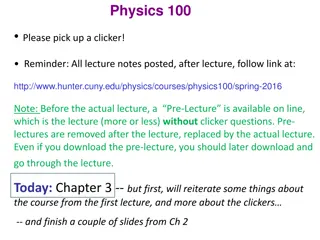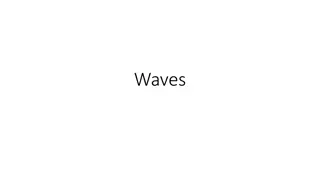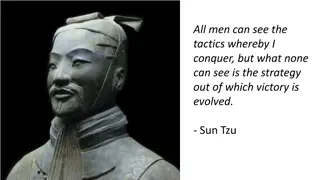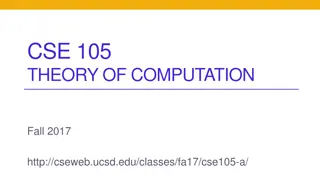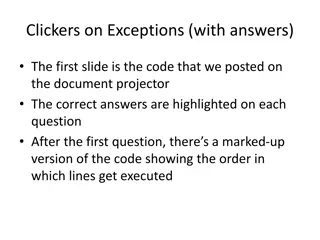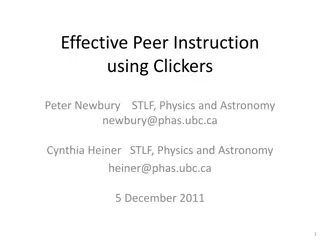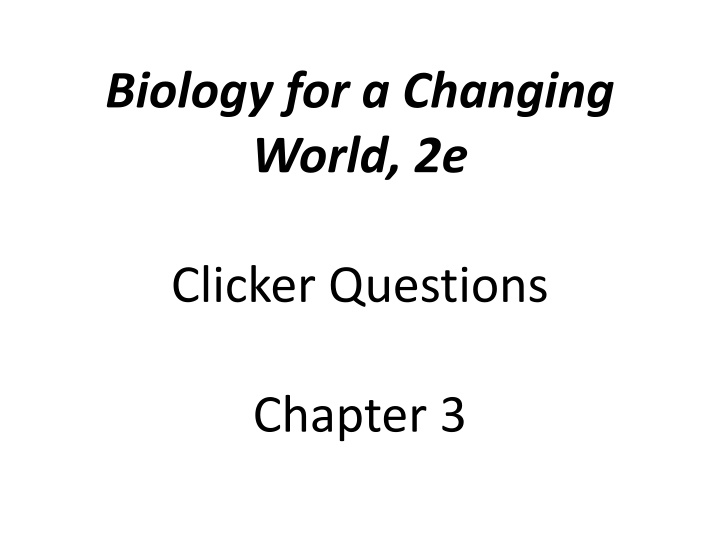
Cell Biology Concepts and Functions Q&A
Explore essential concepts in cell biology through interactive clicker questions covering topics like cell theory, cell structure, membrane permeability, transport mechanisms, and cellular components. Test your knowledge on eukaryotic cells, plasma membranes, diffusion, active transport, and protein synthesis pathways.
Download Presentation

Please find below an Image/Link to download the presentation.
The content on the website is provided AS IS for your information and personal use only. It may not be sold, licensed, or shared on other websites without obtaining consent from the author. If you encounter any issues during the download, it is possible that the publisher has removed the file from their server.
You are allowed to download the files provided on this website for personal or commercial use, subject to the condition that they are used lawfully. All files are the property of their respective owners.
The content on the website is provided AS IS for your information and personal use only. It may not be sold, licensed, or shared on other websites without obtaining consent from the author.
E N D
Presentation Transcript
Biology for a Changing World, 2e Clicker Questions Chapter 3
Cell theory states that A. all living things are composed of protons. B. all living things are composed of cells. C. cells come from other cells. D. B and C
A distinguishing feature of eukaryotic cells is that they A. contain a nucleus and other organelles. B. contain a nucleus only and no other organelles. C. do not contain a nucleus. D. all have cell walls.
Plasma membranes are selectively permeable. This means that A. anything can pass in or out of a cell. B. the plasma membrane regulates passage of material into or out of the cell. C. cholesterol cannot enter the cell. D. plasma membranes must be very thick.
Which of the following substances can easily cross a cell membrane via simple diffusion? A. Na+ B. Large molecules C. Small hydrophobic molecules D. Small hydrophilic molecules
Active transport across a cell membrane requires ______ and moves a substance _____ its concentration gradient. A. energy and transport proteins, with B. energy, with C. transport proteins, against D. energy and transport proteins, against
Water moves across a cell membrane via A. simple diffusion. B. active transport. C. facilitated diffusion. D. None of the above
The instructions for building a glycoprotein are stored in the A. smooth er. B. rough er. C. ribosome. D. nucleus.
A patient is experiencing great fatigue. His doctor informed him that the problem is occurring in his cells. Which cell component is likely the source of his symptom? A. mitochondria B. rough er C. ribosome D. Golgi apparatus
What functions as tracks for organelle movement within the cell cytoplasm? A. plasmodesmata B. cell junctions C. vacuoles D. cytoskeleton
The function of chloroplasts is A. cellular respiration. B. protein synthesis. C. lipid synthesis. D. photosynthesis.
The job of our white blood cells is to defend our bodies against infection by ingesting bacteria. To aid in this task, white blood cells have numerous A. nuclei. B. lysosomes. C. smooth er. D. DNA.
Dr. Cavoline informs you that you need to take your entire prescribed antibiotic. She states that if you do not the A. remaining bacteria will absorb the residual antibiotic. B. residual antibiotic will cause an allergic reaction and you might just possibly die. C. remaining bacteria will reproduce and the offspring could be more resistant to the antibiotic. D. remaining bacteria will die and the shriveled cells will cause secondary infections.

